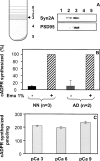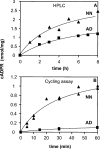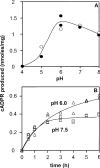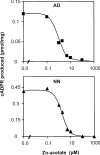The CD38-independent ADP-ribosyl cyclase from mouse brain synaptosomes: a comparative study of neonate and adult brain
- PMID: 16411897
- PMCID: PMC1422756
- DOI: 10.1042/BJ20051321
The CD38-independent ADP-ribosyl cyclase from mouse brain synaptosomes: a comparative study of neonate and adult brain
Abstract
cADPR (cADP-ribose), a metabolite of NAD+, is known to modulate intracellular calcium levels and to be involved in calcium-dependent processes, including synaptic transmission, plasticity and neuronal excitability. However, the enzyme that is responsible for producing cADPR in the cytoplasm of neural cells, and particularly at the synaptic terminals of neurons, remains unknown. In the present study, we show that endogenous concentrations of cADPR are much higher in embryonic and neonate mouse brain compared with the adult tissue. We also demonstrate, by comparing wild-type and Cd38-/- tissues, that brain cADPR content is independent of the presence of CD38 (the best characterized mammalian ADP-ribosyl cyclase) not only in adult but also in developing tissues. We show that Cd38-/- synaptosome preparations contain high ADP-ribosyl cyclase activities, which are more important in neonates than in adults, in line with the levels of endogenous cyclic nucleotide. By using an HPLC method and adapting the cycling assay developed initially to study endogenous cADPR, we accurately examined the properties of the synaptosomal ADP-ribosyl cyclase. This intracellular enzyme has an estimated K(m) for NAD+ of 21 microM, a broad optimal pH at 6.0-7.0, and the concentration of free calcium has no major effect on its cADPR production. It binds NGD+ (nicotinamide-guanine dinucleotide), which inhibits its NAD+-metabolizing activities (K(i)=24 microM), despite its incapacity to cyclize this analogue. Interestingly, it is fully inhibited by low (micromolar) concentrations of zinc. We propose that this novel mammalian ADP-ribosyl cyclase regulates the production of cADPR and therefore calcium levels within brain synaptic terminals. In addition, this enzyme might be a potential target of neurotoxic Zn2+.
Figures








Similar articles
-
CD38 induces apoptosis of a murine pro-B leukemic cell line by a tyrosine kinase-dependent but ADP-ribosyl cyclase- and NAD glycohydrolase-independent mechanism.Int Immunol. 2006 Jul;18(7):1029-42. doi: 10.1093/intimm/dxl037. Epub 2006 May 23. Int Immunol. 2006. PMID: 16720618
-
Changes in CD38 expression and ADP-ribosyl cyclase activity in rat myometrium during pregnancy: influence of sex steroid hormones.Biol Reprod. 2004 Jul;71(1):97-103. doi: 10.1095/biolreprod.103.026245. Epub 2004 Mar 3. Biol Reprod. 2004. PMID: 14998907
-
Catalytic properties of the retinal rod outer segment disk ADP-ribosyl cyclase.Vis Neurosci. 2011 Mar;28(2):121-8. doi: 10.1017/S0952523810000404. Epub 2011 Jan 27. Vis Neurosci. 2011. PMID: 21269544
-
The role of dietary niacin intake and the adenosine-5'-diphosphate-ribosyl cyclase enzyme CD38 in spatial learning ability: is cyclic adenosine diphosphate ribose the link between diet and behaviour?Nutr Res Rev. 2008 Jun;21(1):42-55. doi: 10.1017/S0954422408945182. Nutr Res Rev. 2008. PMID: 19079853 Review.
-
Cyclic ADP-ribose as a universal calcium signal molecule in the nervous system.Neurochem Int. 2007 Jul-Sep;51(2-4):192-9. doi: 10.1016/j.neuint.2007.06.023. Epub 2007 Jun 28. Neurochem Int. 2007. PMID: 17664018 Review.
Cited by
-
Dual role of CD38 in microglial activation and activation-induced cell death.J Immunol. 2008 Jul 1;181(1):92-103. doi: 10.4049/jimmunol.181.1.92. J Immunol. 2008. PMID: 18566373 Free PMC article.
-
A multiscale analysis in CD38-/- mice unveils major prefrontal cortex dysfunctions.FASEB J. 2019 May;33(5):5823-5835. doi: 10.1096/fj.201800489R. Epub 2019 Mar 7. FASEB J. 2019. PMID: 30844310 Free PMC article.
-
Somato-axodendritic release of oxytocin into the brain due to calcium amplification is essential for social memory.J Physiol Sci. 2016 Jul;66(4):275-82. doi: 10.1007/s12576-015-0425-0. Epub 2015 Nov 19. J Physiol Sci. 2016. PMID: 26586001 Free PMC article. Review.
-
Glycosides, depression and suicidal behaviour: the role of glycoside-linked proteins.Molecules. 2011 Mar 23;16(3):2688-713. doi: 10.3390/molecules16032688. Molecules. 2011. PMID: 21441870 Free PMC article. Review.
-
Specific cyclic ADP-ribose phosphohydrolase obtained by mutagenic engineering of Mn2+-dependent ADP-ribose/CDP-alcohol diphosphatase.Sci Rep. 2018 Jan 18;8(1):1036. doi: 10.1038/s41598-017-18393-9. Sci Rep. 2018. PMID: 29348648 Free PMC article.
References
-
- Guse A. H. Cyclic ADP-ribose: a novel Ca2+-mobilising second messenger. Cell. Signalling. 1999;11:309–316. - PubMed
-
- Higashida H., Hashii M., Yokoyama S., Hoshi N., Chen X. L., Egorova A., Noda M., Zhang J. S. Cyclic ADP-ribose as a second messenger revisited from a new aspect of signal transduction from receptors to ADP-ribosyl cyclase. Pharmacol. Ther. 2001;90:283–296. - PubMed
-
- Kinnear N. P., Boittin F. X., Thomas J. M., Galione A., Evans A. M. Lysosome–sarcoplasmic reticulum junctions: a trigger zone for calcium signaling by nicotinic acid adenine dinucleotide phosphate and endothelin-1. J. Biol. Chem. 2004;279:54319–54326. - PubMed
-
- Dammermann W., Guse A. H. Functional ryanodine receptor expression is required for NAADP-mediated local Ca2+ signaling in T-lymphocytes. J. Biol. Chem. 2005;280:21394–21399. - PubMed
Publication types
MeSH terms
Substances
LinkOut - more resources
Full Text Sources
Other Literature Sources
Medical
Molecular Biology Databases
Research Materials

